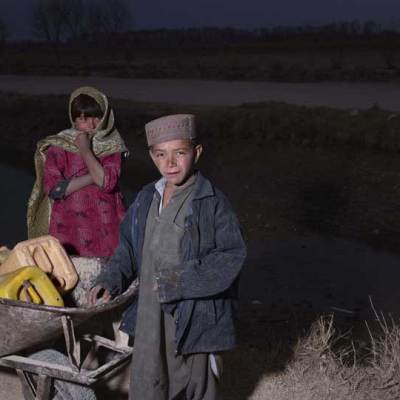How does an art scene evolve if its founding location becomes a war zone? In 2010 the owners of Ayyam Gallery, cousins Hisham and Khaled Samawi, were forced to shut down their Damascus headquarters which they had founded in 2006. Within a matter of months, works by Ayyam’s artists were shipped from Syria to the gallery’s location in Dubai. In relocating, Ayyam and many of its collaborators were torn away from the country intrinsic to their creative infrastructure. ‘Syria’s Apex Generation‘, on show at Ayyam’s London exhibition space, looks at what happens to a burgeoning artistic movement when it’s interrupted.
Untitled (2013), Mohannad Orabi. Image courtesy Ayyam Gallery
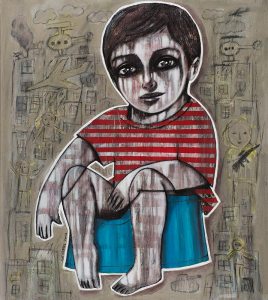
The early 2000s saw a prolific painting movement take place in Syria. The show spotlights its key players, all of whom were based in Damascus before 2010. In 2007 Othman Moussa, Abdul Karim Majdal Al-Beik, Kais Salman, Nihad Al Turk and Mohannad Orabi – all artists working with paint – were brought together by the Shabab Ayyam incubator programme. After meeting they began to advise each other as a creative group, and their collective motifs ranging from warfare and poverty, to rubble and children, can be seen in these canvases. Exhibited together, the works offer an education in an important contemporary Middle Eastern art movement.
Bird (2013), Nihad Al Turk. Image courtesy Ayyam Gallery
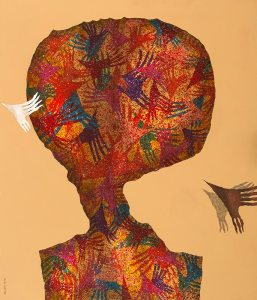
Curated by the gallery’s artistic director Maymanah Farhat, the included canvases are a response to the warfare in Ayyam’s founding city, executed through the medium of paint and conveying the awkward status of an artist uprooted. Mohannad Orabi looks at violence and terror in Untitled, a depiction of a docile child potty training while a horrific scene of battle and destruction lies roughly sketched in the background. There are abstract references to war here too. Nihad Al Turk’s Bird looks at the possibility of peace whilst Abdul Karim Majdal Al-Beik’s Massacre references the Middle Eastern modernist movement. There’s plenty of room for surrealism too: Othman Moussa’s The Terror Group interprets the Syria conflict through a single apple rendered with Magritte reminiscent precision.
The Terror Group (2014), Othman Moussa. Image courtesy Ayyam Gallery
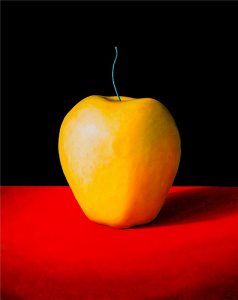
Disappointingly there are no female artists in the show. Whilst Kais Salman attempts to highlight the realities of modern Syrian womanhood in Mirrors – depicting female nudes with red eyes, distorted faces and often in a state of undress – a female perspective is crucial in a show looking at Syria’s contemporary culture, and the lack of it here is palpable.
The exhibition has toured three cultural capitals – Dubai, Beirut and London, each location representing different facets of the Middle East’s contemporary art scene. A Beirut audience may experience the show differently to one in Dubai or London. In the aftermath of 2010, there was a mass gallery exodus, with most fleeing the country. Many independent art spaces have moved to Beirut, a country which like Syria, has a capital whose cultural history is part of its modern artistic identity. Along with Dubai, the city will be crucial in the evolution of Middle Eastern art. The show’s curation reflects this, featuring pieces that are both challenging and representative.
Mirrors (2012), Kais Salman. Image courtesy Ayyam Gallery
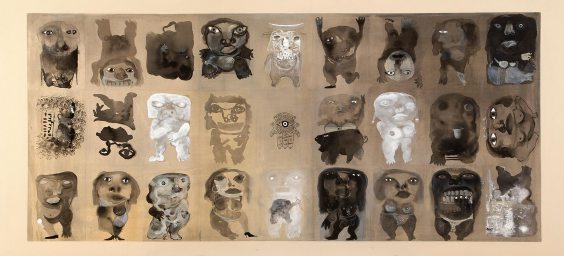
This exhibition could have taken a general look at Syrian art, but instead, the intricacies of being part of an artistic scene halted by war are played out with candour and honesty. History may be easy to destroy on street level, but art has the power to maintain cultural identity.
‘Syria’s Apex Generation’ is at Ayyam Gallery, London, until 12 September.

